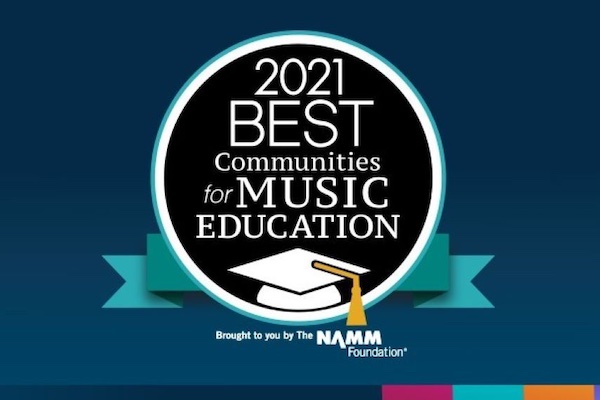This week, the NAMM Foundation celebrated and recognized 686 school districts in 40 states as among the Best Communities for Music Education (BCME). Despite schools moving online or to in-person settings where masks were required not only for student musicians but often for instruments, K-12 music teachers have found creative solutions to make music come alive.
“In past years, schools and districts had to work hard to create successful music and arts communities,” said Mary Luehrsen, executive director of The NAMM Foundation. “But, never before has the battle been so hard-fought against silence and a feeling of isolation. We applaud with all our hearts the commitment of so many to assure students continue with deep and rich music learning.”
In 2020, as districts shut down for in-person learning, teachers began sending sheet music, videos and audio to students via the internet. Classes went from the band room to Zoom. Music education became much more individualized and difficult.
“The truth is, music is not meant to be done alone,” said Samantha Sarli of the Bristol Public School in Bristol, Conn. “Our students miss their large ensemble experience. Music is very much about the feeling of being in a room with 70 to 90 other students and physically feeling the vibrations, following the conductor and learning where your part fits into the larger picture.”
Playing together is possible, but hard to manage online. The technology tends to lag and distort the sound. The camera also is a problem for teachers because it generally only shows one angle.
Yet in the schools and districts recognized by The NAMM Foundation this week, dedicated and creative music teachers, supported by a wider community, have succeeded in reinventing music instruction. In so doing, they have brightened the lives of thousands of students, breaking down isolation.
“Countless hours have been spent creating virtual ensemble performance, delivering music to students’ houses, repairing instruments on students’ front porches, and more,” said Allison Rakickas of the Aptakisic-Tripp Community Consolidated School District 102 in Buffalo Grove, I.L.
Breaking out of the routine also has advantages. “I believe that teaching in a hybrid educational system has forced us to think outside the box of what a traditional music performance class is,” said Chris Clouthier of the Port Washington Saukville School District in Port Washington, N.Y.
“Teachers are able to teach more in-depth about theory, ear training, and creating music,” said April Pickrell of the Santa Fe Public Schools in Santa Fe, N.M. “Many times, teachers are so wrapped up in the next concert that these other skills are not as prominent.”
In addition to the districts receiving Best Communities for Music Education recognition, 80 individual schools across the nation are being awarded the SupportMusic Merit Award (SMMA), which recognizes support for school-based music education programs.
In cooperation with researchers at the Music Research Institute at the University of Kansas, the BCME program, now in its 22nd year, evaluates schools and districts based on funding, staffing of highly qualified teachers, commitment to standards, and access to music instruction.
In past years, a BCME designation has helped raise local awareness of quality music programs from coast to coast. Earning the designation has assisted communities in securing funds for music programs threatened by budget cuts and acts as a source of community pride. News of past winners being recognized nationally often leads to local media coverage and additional community recognition.
The lesson from this year of pandemic, according to Rebekah Valerio of the Newark Central School District in Newark, N.Y., is this:
”Keep making music, no matter what. Offer the same opportunities even if the final product may look different. Focus on the process and less on the product.”
For more news from the Music & Sound Retailer, click here.


